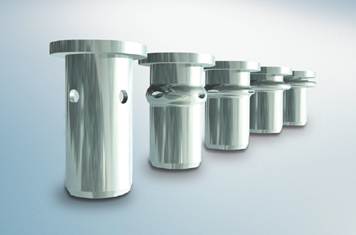
Glass reinforced plastic (GRP) and carbon-fibre reinforced plastic (CFRP) boards are every engineer’s nightmare. How does an engineer create a stable connection point using a blind hole? The obvious solution is a blind rivet nut.
They do have their drawbacks, however. When a standard blind rivet is set into a blind hole, bulge formation is uncontrolled. That leaves stability and safety to pure chance.
The Bossard ecosyn®-BCT blind rivet nut is able to control the bulge without support from the base material. Crossholes deliberately weaken the shank material and thus define the bulge’s position and form. Like a standard blind rivet nut, the Bossard ecosyn®-BCT can be set ‘blind’ from one side, efficiently and without rework.

These properties make the Bossard ecosyn®-BCT blind rivet the ideal product for tight spots or where performance demands are high, such as in thin-walled, high-tensile, soft, porous or sandwich materials. They are suitable for use in GRP and CFRP structures, lightweight honeycomb panels, profiles, ductwork and other hard-to-access types of structures.
The Bossard ecosyn®-BCT blind rivet nut especially shines when multiple components must be joined. With standard blind rivets, the bulge forms uncontrolled in the plane of least resistance. In the worst case scenario, the bulge forms in the gap between the two riveted elements. The Bossard ecosyn®-BCT blind rivet nut is different. With controlled deformation, all materials are drawn together between the flange head and bulge, creating a stable rivet. The bulge forms without bearing stress, with minimal tension on the surface of the bore. This keeps the risk of skewing or misalignment to a minimum.
Often the hole diameter is undefined. Conventional blind rivet nuts need support from the shaft in the bore, causing skewing of the rivet, misalignment or reduced strength. In contrast, the Bossard ecosyn®-BCT rivet nut forms the bulge first, eventually becoming flush with the base material.
If the material thickness is unclear, the Bossard ecosyn®-BCT Multigrip blind rivet nut offers the ideal solution. Depending on the thread diameter, it covers a grip range of up to 9mm. The standard grip range of a conventional blind rivet is only 2.5mm. If the material thickness does not match, either no bulge can form or the threaded axis sits off-centre.
Varying material thicknesses present yet another problem. The risk of using the wrong blind rivet nut is higher when the thickness of the materials varies. In addition, the limited grip range of conventional blind rivet nuts requires keeping a large selection of sizes on hand. Since the Bossard ecosyn®-BCT blind rivet nut covers a very wide grip range, the right rivet nut for the job is always available without the need for a large inventory.
Often connection points for high-strength screw joints are needed, a nearly impossible task for conventional blind rivet nuts. Achieving the required tensile strength requires increasing the number of attachment points or the thread diameter.
Bossard ecosyn®-BCT offers an elegant solution - blind rivet nuts of high-grade material. Versions made of steel are able to withstand the tensile strength of a 12.9 screw, and their aluminium counterparts can bear 8.8. These properties allow the rivet nut to be firmly anchored in virtually any material, even if it is much softer.
Where space is tight, e.g. small diameter tubes or interfering edges, standard blind rivet nuts are too long. Without contact to the base material while setting, the blind rivet nut will not seat securely.
The Bossard ecosyn®-BCT Micro provides just the right solution. It creates a sturdy attachment point even in tight quarters, including in steel up to a load of an 8.8 screw. This ensures a firm attachment where insertion depth is low and in narrow sandwich panels (e.g. M6 in 10mm aluminium panel) or round and square tubes with small diameters.
Moreover the flange (head) that creates the bulge does not need to rest on the front of the base material; the crossholes just need to protrude out the back by approximately 1mm. This pulls the flange against the front as the bulge forms.
Sometimes it is necessary to keep the weight of the component light. Here, too, the Bossard ecosyn®-BCT Micro is the rivet nut of choice. Unlike a conventional blind rivet nut, the Micro is made of higher grade material with fewer threads, which generally makes it lighter.

Having spent a decade in the fastener industry experiencing every facet – from steel mills, fastener manufacturers, wholesalers, distributors, as well as machinery builders and plating + coating companies, Claire has developed an in-depth knowledge of all things fasteners.
Alongside visiting numerous companies, exhibitions and conferences around the world, Claire has also interviewed high profile figures – focusing on key topics impacting the sector and making sure readers stay up to date with the latest developments within the industry.
Don't have an account? Sign Up
Signing up to FastFixTechnology.com enables you to manage your account details.